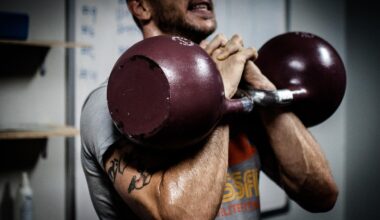Aerobic Conditioning Focused on Endurance Sports
Aerobic conditioning plays a crucial role in enhancing performance in endurance sports such as running, cycling, and swimming. Athletes in these disciplines must develop a strong cardiovascular system to sustain prolonged periods of activity. To achieve optimal aerobic conditioning, a structured training program focusing on long-duration, moderate-intensity workouts is essential. These sessions can include steady-state runs or cycling at a pace where conversation remains possible. The key is to maintain a heart rate within the target aerobic zone, ensuring that fat becomes the primary fuel source. Implementing interval training is effective for enhancing aerobic capacity. Athletes should incorporate sessions where short bursts of high-intensity effort are followed by recovery periods. This not only raises the lactate threshold but also improves efficiency in oxygen usage. Complementary activities like cross-training help reduce the risk of overuse injuries while promoting overall fitness. Dietary considerations must include sufficient carbohydrates for energy and hydration strategies tailored to individual needs. A sports nutritionist can assist in crafting a personalized meal plan. Overall, dedication to aerobic conditioning is critical in achieving peak performance in endurance sports without compromising health.
Tailored Approaches for Team Sports
In team sports, such as soccer, basketball, and rugby, aerobic conditioning strategies are distinct. While endurance is essential, the nature of team sports often demands anaerobic fitness as well. Consequently, training should encompass both aerobic and anaerobic components to develop a versatile athlete. Long-distance runs may facilitate aerobic base building, but sport-specific drills, such as shuttle runs and small-sided games, should dominate training sessions. These activities boost aerobic capacity while mimicking match conditions, thereby improving players’ ability to recover during short bursts of high-intensity play. Additionally, implementing circuit training can enhance both aerobic and anaerobic power, ensuring a comprehensive approach. Coaches should monitor players’ heart rates during training sessions to maintain appropriate intensity levels. Nutrition remains vital; athletes should be educated on timing their meals to optimize performance and recovery. Consuming a mix of proteins and carbohydrates post-exercise can speed up recovery. Furthermore, tailored strategies should consider individual fitness levels and positions within the team to ensure effective training. By recognizing and respecting these variances, athletes can enhance their performance while minimizing injury risks in the competitive environment of team sports.
Aerobic Conditioning for Combat Sports
Combat sports like boxing, martial arts, and mixed martial arts require a unique approach to aerobic conditioning. Unlike traditional endurance sports, athletes in combat sports need to balance aerobic fitness with explosive power and agility. Training should involve interval workouts that enhance cardiovascular endurance without sacrificing strength. For instance, sparring sessions, which incorporate both high-intensity efforts and rest intervals, not only build aerobic capacity but also simulate competition conditions. Additionally, running drills that alternate between sprints and jogging can improve heart rate variability, crucial for recovery during matches. Circuit training with bodyweight exercises, such as push-ups and burpees, can further contribute to conditioning while improving muscular endurance. Athletes should also focus on flexibility and mobility components, as these contribute to overall performance in combat situations. Proper nutrition plays a pivotal role, with an emphasis on lean proteins, complex carbohydrates, and hydration strategies. Incorporating recovery techniques, like active rest and stretching, aids in preventing injuries and ensuring longevity in the sport. Ultimately, a well-rounded aerobic conditioning plan tailored specifically to combat scenarios will produce agile and durable athletes ready for competition.
Adapting Aerobic Conditioning for Individual Sports
Aerobic conditioning for individual sports, including tennis, gymnastics, and swimming, necessitates a more specialized approach. Athletes must cultivate sport-specific skills while enhancing their aerobic capabilities. For example, swim training often includes long-distance sets mixed with sprint repeats to develop both endurance and speed, directly correlating to competition performance. In tennis, agility drills and specific rally simulations can improve both aerobic fitness and on-court endurance. Additionally, incorporating resistance training can support the development of overall strength while enhancing aerobic capacity. A balanced workout routine incorporating flexibility exercises can also prevent injuries while maintaining performance levels. Furthermore, individualized nutrition plans tailored to each athlete’s specific demands play a critical role. Athletes should focus on pre- and post-training meals that support energy needs and recovery processes. Consuming adequate hydration before, during, and after sessions becomes even more crucial when considering individual training dynamics. Furthermore, tracking progress by monitoring heart rates and perceived exertion levels can provide valuable insights into training effectiveness. By aligning aerobic conditioning with specific sport demands, athletes can achieve peak performance tailored uniquely to their sport.
The Role of Technology in Aerobic Conditioning
The integration of technology in aerobic conditioning has revolutionized the way athletes train. Wearable devices, such as fitness trackers, heart rate monitors, and smartwatches, provide valuable data that enable athletes to optimize their training sessions. By tracking heart rates, strides, and calories burned, athletes can fine-tune their workouts to meet specific conditioning goals. Many of these devices also offer insights into recovery needs, allowing for more effective planning of training cycles. Training apps enable the customization of workouts tailored to aerobic conditioning, ensuring that athletes remain engaged and motivated. Furthermore, data analytics can identify performance trends over time, helping athletes make informed decisions about their training routines. Virtual training sessions and online coaching platforms have also gained popularity, providing resources to enhance performance. These platforms offer access to expert advice and customizable plans suited to individual needs. Despite the benefits of technology, it’s essential for athletes to maintain a focus on proper techniques and strategies rather than relying solely on gadgets. Ultimately, effective aerobic conditioning remains grounded in a well-balanced approach that integrates technology as a valuable aid rather than a crutch.
Common Mistakes in Aerobic Conditioning
Aerobic conditioning, while vital, can be hindered by common mistakes that athletes often make. One frequent error is neglecting recovery; overtraining can lead to burnout, injuries, and diminished performance. Athletes must understand the importance of rest days and active recovery techniques, which can promote muscle repair. Another mistake is the failure to periodize training effectively. Without a structured plan, athletes risk plateauing and compromising their conditioning progress. Incorporating various training intensities, distances, and modes can mitigate this issue by introducing variety into workouts. Additionally, many athletes underestimate the role of nutrition; training without adequate fuel can lead to fatigue, poor performance, and slower recovery rates. Regularly assessing carbohydrate, protein, and hydration levels is critical to maintaining a well-balanced diet. Some athletes are also drawn to excessive high-intensity workouts, neglecting the steady-state sessions that are fundamental for building aerobic capacity. Striking a balance between different workout types is essential for long-term success. By recognizing these common pitfalls and addressing them thoroughly, athletes can enhance their aerobic conditioning and ensure their training delivers maximum results.
Monitoring Progress in Aerobic Conditioning
Monitoring progress in aerobic conditioning is essential for athletes aiming to enhance performance systematically. Regular fitness assessments, such as VO2 max tests or timed distance runs, can provide valuable benchmarks for improvement. These assessments allow athletes to gauge aerobic capacity and adjust training regimens accordingly. Incorporating interval training techniques, athletes can measure recovery times and adaptations, which serve as markers for overall progress. Maintaining a training log to record workouts, heart rates, and perceived exertion levels can help athletes visualize their advancements and identify areas in need of improvement. Special attention should be paid to long-term trends rather than short-term fluctuations, as aerobic conditioning is a gradual process. Implementing periodic evaluations every few weeks can yield insights into effectiveness and adaptability of training modalities. Combining quantitative and qualitative data empowers athletes to optimize their conditioning plans. Collaborating with coaches or trainers to review progress and adjust strategies can also foster a supportive training environment. Ultimately, prioritizing consistent monitoring and evaluation of aerobic conditioning efforts will significantly enhance an athlete’s training success.
Conclusion: The Importance of Aerobic Conditioning in Sports
Aerobic conditioning remains a fundamental component across all sports disciplines. Each athlete must recognize their specific aerobic demands based on their sport’s unique requirements to tailor effective training. By focusing on continuous improvement, adaptable strategies, and proper nutrition, athletes can ensure they maximize their performance potential. Furthermore, the integration of technology and awareness of common mistakes enhances training effectiveness, allowing athletes to refine their approach continuously. Customizing conditioning plans according to individual fitness levels and objectives fosters a greater understanding of one’s body and its responses to training. Ultimately, the pursuit of excellent aerobic conditioning not only leads to peak performance but also promotes overall health and longevity in sports. Taking a holistic approach that encompasses an athlete’s mindset, physical capabilities, and environmental factors will result in a comprehensive strategy that yields long-term success. By prioritizing aerobic conditioning and recognizing its importance, athletes can elevate their performance and enjoy their chosen sport for years to come. As every athlete discovers their approach, they pave the way for a more rewarding experience in their athletic journey.





